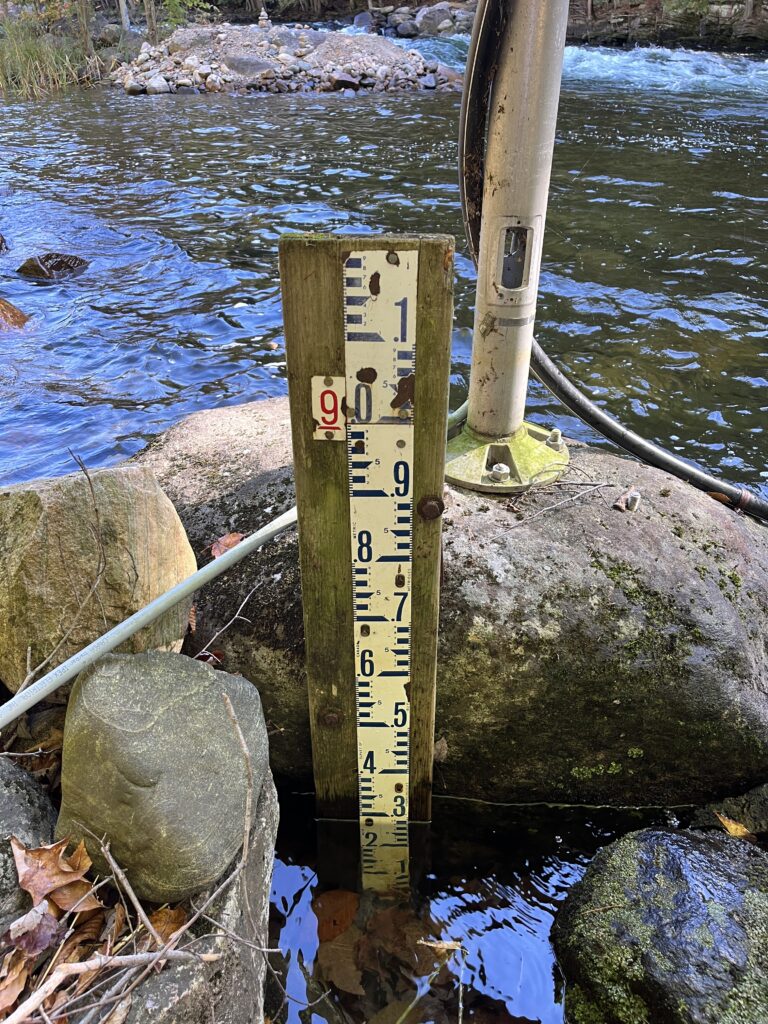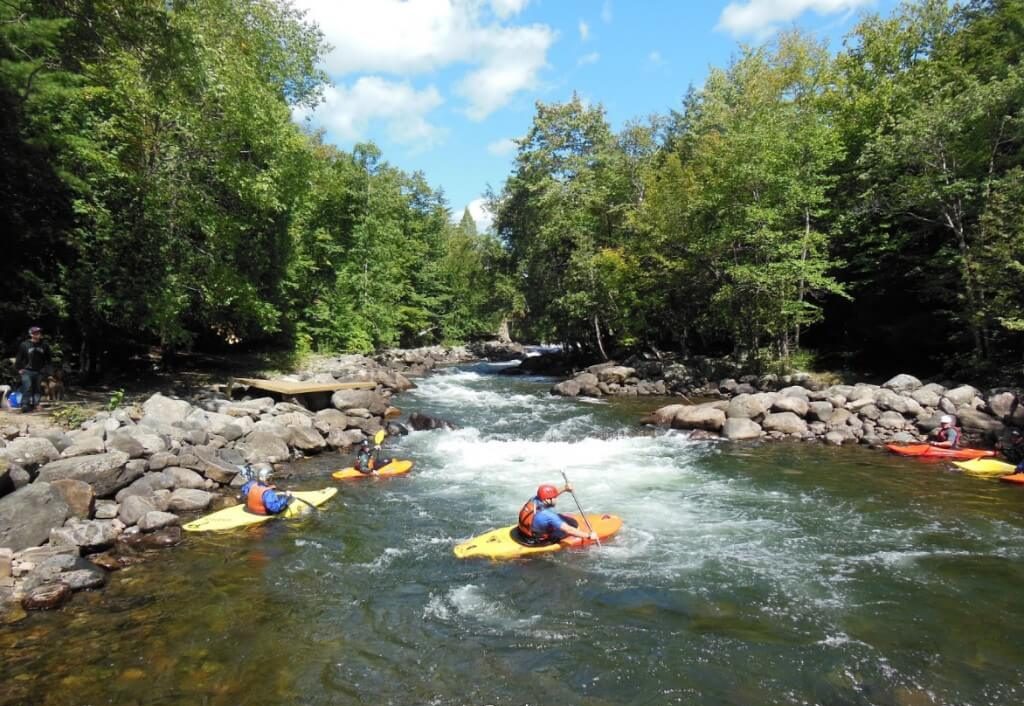Whitewater Ontario administers and maintains the Minden Whitewater Preserve that is located adjacent to the Gull River. A river map is located in beside the Training Centre on river left, as well as on river right in the parking lot off Horseshoe Lake Rd.

The Gull River and Preserve are located in Minden Ontario approximately 2.5 hours north of Toronto, 4 hours south west of Ottawa. The site has been the Canadian stop on the World Cup Slalom tour in 1991 and 1993. There are 12,000 user days each year of the whitewater section of the river and the land beside it.
Parking is available at a small put-in midway down the top half of the river on the south side of County Road #20. There is a large parking lot on the north side of County Rd #20 and at the Training Centre. Do not park on shoulder of County Rd #20 or on Horseshoe Lake Road.
River Flow
Spring flows range from 25 m3/second – 50 m3/second (825 cfs – 1650 cfs). International races run with flows at 22-28 m3/second (725 cfs to 925 cfs). Usual summer flows range from 10 m3/second – 18 m3/second. Below 10 m3/second is too shallow and can be dangerous.
River levels can be read on the stick gauge located on river right near the parking lot.
Low = <8.1
Medium = 8.1-8.5
High = 8.5-9.0
Flood = >9.0

One Paddlers Opinion
In terms of whitewater it’s pretty hard to beat the Gull River in Minden next to the Minden Wildwater Preserve. No it’s not the Grand Canyon, and it’s kind of dinky compared to the other gem of Ontario, the Mighty Ottawa. But what it lacks in size it makes up for in attitude. There are Class 4 moves and near Class 5 moves all over this short stretch of technical whitewater yet an advanced intermediate with strong Class 3 skills can run all of it. There are put in options for less skilled novices and a decent outflow where a pretty friendly but dynamic wave can be found. Some of the best paddlers in Ontario have made this river a training ground and various events bring all sorts of boaters from around the world to paddle and camp here. One renowned C-Boater refers to the demanding play hole called Earls as “The Lab”. It’s no Bussy, not even a Phil’s Hole, but if you can master this little technical hole you probably can take your mojo over to the Ottawa and get noticed. That being said its not unusual to find an Ottawa regular flushing down the harder potions of the Gull with a bewildered look on their face. This “creek” has velocity not obvious to the first timer, check the Gull out slowly and in controlled eddy hops on your inaugural visit, otherwise you might end up surfing the wash out wave in a hurry wondering if your boat is up or downstream. The local experts and there are plenty maintain that if you can sort out and master the tough moves on the Gull your pretty much ready to go anywhere. In terms of water quality it’s clean, warm, and flows at runnable levels most of the year. There are no wild variations in level due to release / hydro manipulations however it is a controlled system and the resulting management pretty much guarantees the Gull having water when most if not all other rivers are at their lowest summer levels. You can count on the Gull improving as the summer progresses which is perfect since that is the opposite of what most other rivers are doing.
The River Features
The river’s whitewater section is 800 meters long and ranges from Class II to III. The river is most difficult at the top ending in Class II at the washout. The class of the river is a result of the fast pushy water, especially at high levels and the nasty consequences of a swim on most of the river. The river is dam controlled and runs from a large eddy pool below the dam, through a small drop into a channel that runs to Earl’s hole, a popular playspot. The river below the eddies of Earl’s run’s in a wide C-curve and ends at Whitehorse Falls. The top section of the Gull is for skilled paddlers only. The consequences of a swim are exceptionally nasty on the top half of the river.



Whitehorse falls runs into a large eddy pool, a popular starting point for open boats and intermediate paddlers. The middle of the river runs in through a number of bends, offering lots of opportunities to practice river running skill. Caution is required due to a number of rocks quite capable of pinning a boat in a broach pin. The river here is fast and relatively shallow. The middle section ends in a large eddy pool on river right, next to a footbridge and walking access to County Road #20. There is a large rock on river left that is boof-able into a smallish eddy at higher water.

While the middle section is relatively easier than the top section, the consequences of a swim are not pleasant. A solid roll is pretty much a requirement, especially given the upcoming Otter Slide.
The last third of the Gull runs past a large rock midline with a few micro eddies on river right and one large one of river left before coming to the Otter Slide. The Otter Slide is a fast shallow slide that ends in a few standing waves that can be surfable. Swimming or going over the Otter Slide is dangerous due to how shallow it is and the numerous small rock outcroppings at the base. If you find your self swimming above it, abandon your gear and swim like a maniac for the shore.

The lower lake and washout area is appropriate for beginners. The outwash from the Otter Slide can form a surfable wave and two strong eddy lines for practicing turns. At low lake levels a large rock shelf emerges on river left and a small hole forms. At lower lake levels, a ledge and hole appears on river right. Be cautious at these small features as the shallowness of the features can make an upstream flip disasterous.

River Development
Monies raised through donations and grants and WO programs have allowed Whitewater Ontario and numerous other volunteers, to undertake restoration of the Gull River.
In 1970 a group of whitewater paddlers modified the river with heavy machinery to create Canada’s first artificially enhanced whitewater preserve. Over 20 years of spring floods have altered river features and dislodged large boulders eventually rendering the waterway unsafe for all users. In 2000 a plan of River Restoration, River Development, and Site Development was undertaken and completed. These modifications gave priority to preserving environmental value, paddlers’ safety, recreational use, competitive use, historical value, and the potential for future development.
History of the Gull River / Minden Whitewater Preserve
On September 13th, 1980 the official opening of the Minden Wild Water Preserve (now the Minden Whitewater Preserve) took place at the Gull River. The ceremony, which was hosted by visionary Roger Parsons, was a culminating moment for a project that was started in May, 1977 by the Ontario Wild Water Affiliation (the predecessor of Whitewater Ontario). Thirty years later, the result of the work of these dedicated volunteers is one of admiration, respect, and gratitude for developing the Gull River into one of North America’s finest whitewater venues. Since those opening ceremonies, the Gull has been the site of several National Championships and World Cups as well as numerous races and events. It is stretch of whitewater that has drawn paddlers from across our country and from other nations who have left knowing they have paddled in a very special place.
Whitewater Ontario proudly salutes Roger Parsons and all of the volunteers who made this happen. We will continue to build on the vision that was established over thirty years ago and ensure that the Gull remains central to paddling in Ontario and that future generations will enjoy this beautiful river.

